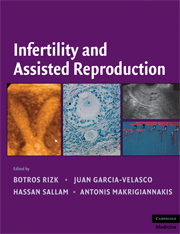Book contents
- Frontmatter
- Contents
- Contributors
- Foreword
- Preface
- Introduction
- PART I PHYSIOLOGY OF REPRODUCTION
- PART II INFERTILITY EVALUATION AND TREATMENT
- PART III ASSISTED REPRODUCTION
- 38 Medical Strategies to Improve ART Outcome: Current Evidence
- 39 Surgical Preparation of the Patient for In Vitro Fertilization
- 40 IVF in the Medically Complicated Patient
- 41 Polycystic Ovary Syndrome and IVF
- 42 Endometriosis and Assisted Reproductive Technology
- 43 Evidence-Based Medicine Comparing hMG/FSH and Agonist/Antagonist and rec/Urinary hCG/LH/GnRH to Trigger Ovulation
- 44 Luteal Phase Support in Assisted Reproduction
- 45 Thrombophilia and Implanation Failure
- 46 Intrauterine Insemination
- 47 The Prediction and Management of Poor Responders in ART
- 48 Oocyte Donation
- 49 In Vitro Maturation of Human Oocytes
- 50 Oocyte and Embryo Freezing
- 51 Cryopreservation of Male Gametes
- 52 The Management of Azoospermia
- 53 Spermatid Injection: Current Status
- 54 Optimizing Embryo Transfer
- 55 Single Embryo Transfer
- 56 Blastocyst Transfer
- 57 Clinical Significance of Embryo Multinucleation
- 58 Quality and Risk Management in the IVF Laboratory
- 59 The Nurse and REI
- 60 Understanding Factors That Influence the Assessment of Outcomes in Assisted Reproductive Technologies
- 61 The Revolution of Assisted Reproductive Technologies: How Traditional Chinese Medicine Impacted Reproductive Outcomes in the Treatment of Infertile Couples
- 62 Complications of Assisted Reproductive Technology
- 63 Ectopic and Heterotopic Pregnancies Following in Vitro Fertilization
- 64 The Impact of Oxidative Stress on Female Reproduction and ART: An Evidence-Based Review
- 65 PGD for Chromosomal Anomalies
- 66 Preimplantation Genetic Diagnosis for Single-Gene Disorders
- 67 Epigenetics and ART
- 68 Congenital Anomalies and Assisted Reproductive Technology
- PART IV ETHICAL DILEMMAS IN FERTILITY AND ASSISTED REPRODUCTION
- Index
- Plate section
- References
43 - Evidence-Based Medicine Comparing hMG/FSH and Agonist/Antagonist and rec/Urinary hCG/LH/GnRH to Trigger Ovulation
from PART III - ASSISTED REPRODUCTION
Published online by Cambridge University Press: 04 August 2010
- Frontmatter
- Contents
- Contributors
- Foreword
- Preface
- Introduction
- PART I PHYSIOLOGY OF REPRODUCTION
- PART II INFERTILITY EVALUATION AND TREATMENT
- PART III ASSISTED REPRODUCTION
- 38 Medical Strategies to Improve ART Outcome: Current Evidence
- 39 Surgical Preparation of the Patient for In Vitro Fertilization
- 40 IVF in the Medically Complicated Patient
- 41 Polycystic Ovary Syndrome and IVF
- 42 Endometriosis and Assisted Reproductive Technology
- 43 Evidence-Based Medicine Comparing hMG/FSH and Agonist/Antagonist and rec/Urinary hCG/LH/GnRH to Trigger Ovulation
- 44 Luteal Phase Support in Assisted Reproduction
- 45 Thrombophilia and Implanation Failure
- 46 Intrauterine Insemination
- 47 The Prediction and Management of Poor Responders in ART
- 48 Oocyte Donation
- 49 In Vitro Maturation of Human Oocytes
- 50 Oocyte and Embryo Freezing
- 51 Cryopreservation of Male Gametes
- 52 The Management of Azoospermia
- 53 Spermatid Injection: Current Status
- 54 Optimizing Embryo Transfer
- 55 Single Embryo Transfer
- 56 Blastocyst Transfer
- 57 Clinical Significance of Embryo Multinucleation
- 58 Quality and Risk Management in the IVF Laboratory
- 59 The Nurse and REI
- 60 Understanding Factors That Influence the Assessment of Outcomes in Assisted Reproductive Technologies
- 61 The Revolution of Assisted Reproductive Technologies: How Traditional Chinese Medicine Impacted Reproductive Outcomes in the Treatment of Infertile Couples
- 62 Complications of Assisted Reproductive Technology
- 63 Ectopic and Heterotopic Pregnancies Following in Vitro Fertilization
- 64 The Impact of Oxidative Stress on Female Reproduction and ART: An Evidence-Based Review
- 65 PGD for Chromosomal Anomalies
- 66 Preimplantation Genetic Diagnosis for Single-Gene Disorders
- 67 Epigenetics and ART
- 68 Congenital Anomalies and Assisted Reproductive Technology
- PART IV ETHICAL DILEMMAS IN FERTILITY AND ASSISTED REPRODUCTION
- Index
- Plate section
- References
Summary
INTRODUCTION
The first in vitro fertilization (IVF) baby was born after a natural IVF cycle. In the early days of IVF, clomiphene citrate was used for ovarian stimulation, and later urinary gonadotrophins were used for controlled ovarian hyperstimulation. A decade later, recombinant follicle-stimulating harmone (FSH) was produced (2), and since then, there is an ongoing debate between using urinary versus recombinant gonadotrophins (3).
From the mid-1980s, ovarian stimulation protocols combined the use of gonadotrophins with gonadotrophin-releasing hormone agonist (GnRHa) in order to increase oocyte number and to avoid premature luteinizing hormone (LH) surge (4). In the twenty-first century, GnRH antagonist became available as an alternative to GnRHa (5).
With the recent interest in evidence-based medicine, it would be logical to search for the optimum protocol of ovarian stimulation, decreasing rate of OHSS, and yet achieving at least the same success rate to provide our patients with the best possible care. Randomized controlled trials and systematic reviews are considered the source of the top-quality evidence. One big advantage of systematic reviews is pooling the results of studies with similar methodology and addressing the same topic, hence achieving large sample size and tightening the confidence in the results obtained (Al-Inany et al., 2003).
COH PROTOCOLS: WHAT CHALLENGED THE GOLDEN RULE?
Pharmaceutical preparations of human gonadotrophins play an important role to achieve multifollicular development (6).
Keywords
- Type
- Chapter
- Information
- Infertility and Assisted Reproduction , pp. 386 - 394Publisher: Cambridge University PressPrint publication year: 2008



